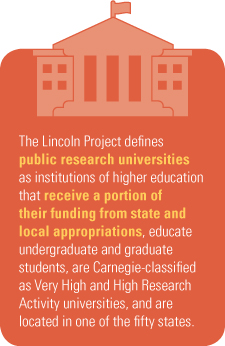Introduction

Public research universities support America’s technological innovation, its democratic vitality, and the promise of opportunity for the next generation. Although they represent only 3 percent of the total number of institutions in the U.S. higher education system, their impact is profound. Public research universities transform the lives of the students and families they serve; and they improve the well-being of the entire nation—and much of the global community—through contributions to research, infrastructure, our knowledge base, and the economy.
 Public
research universities educate about 20 percent of all students nationwide; among
the nation’s research universities, they award 65 percent of all master’s
degrees and 68 percent of all research doctorate degrees. They enroll 3.8 million
students, including almost 900,000 graduate students, annually.1 Public research universities
produce researchers, educators, entrepreneurs, civic leaders, and the basic research
breakthroughs that drive innovation, grow our economy, and benefit the daily lives
of all Americans.2
Between 2012 and 2013 alone, research at public universities resulted in more than
13,322 patent applications, 522 start-up companies, and 3,094 intellectual property
licenses.3
Public
research universities educate about 20 percent of all students nationwide; among
the nation’s research universities, they award 65 percent of all master’s
degrees and 68 percent of all research doctorate degrees. They enroll 3.8 million
students, including almost 900,000 graduate students, annually.1 Public research universities
produce researchers, educators, entrepreneurs, civic leaders, and the basic research
breakthroughs that drive innovation, grow our economy, and benefit the daily lives
of all Americans.2
Between 2012 and 2013 alone, research at public universities resulted in more than
13,322 patent applications, 522 start-up companies, and 3,094 intellectual property
licenses.3
Public research universities also support the upward social mobility of large numbers of talented and ambitious young people from low socioeconomic status backgrounds, many of whom are the first in their family to pursue postsecondary education. Public research universities provide a high-quality university education at reduced cost and act as pathways to higher-paying jobs than would otherwise be obtainable for most students. The sizable enrollment of undergraduate students from low-income families reflects the mission of public research universities to serve all facets of U.S. society; 31 percent of undergraduate students who attend public research universities receive Pell Grants, and the eight research universities with the highest shares of students who receive Pell Grants are all public.4
But there is growing concern about the future of these vital institutions. Over the last decade, and especially following the economic collapse of 2008, nearly every state in the nation has dramatically reduced its investment in higher education, with public research universities receiving the most severe cuts. Since 2008, public research universities have suffered a 26 percent drop in state investment.5 Further, declining federal funds for research have added to the strain, despite the slight rebound afforded by the 2016 omnibus spending measure. The current funding model is broken and getting worse, putting at risk a critical component of the nation’s postsecondary education system and research infrastructure.
The American Academy of Arts & Sciences has created the Lincoln Project: Excellence and Access in Public Higher Education to study the importance of public research universities, analyze economic trends affecting their operation, and recommend new strategies to sustain and strengthen these critical institutions. This publication, the fourth in a series of five Lincoln Project reports, examines the many ways in which public research universities contribute to their communities, states, regions, and the nation, and provides empirical evidence of their service to the public good.
ENDNOTES
1 See National Center for Education Statistics, IPEDS [Integrated Postsecondary Education Data System] (U.S. Department of Education, Institute of Education Sciences), https:// nces.ed.gov/ipeds/.
2 National Center for Education Statistics, IPEDS Analytics: Delta Cost Project 1987 – 2012 Database, https://nces.ed.gov/ipeds/deltacostproject/.
3 Association of University Technology Managers, AUTM Licensing Activity Survey FY2013 (Deerfield, Ill.: Association of University Technology Managers, 2014).
4 National Center for Education Statistics, IPEDS. Economic diversity at top colleges varies widely; see David Leonhardt, “California’s Upward-Mobility Machine,” The New York Times, September 16, 2015, http://www.nytimes.com/2015/09/17/upshot/californias-university-system-an-upward-mobility-machine.html.
5 Analysis of data from State Higher Education Executive Officers (SHEEO) Association, SHEF: FY 2014—State Higher Education Finance (Boulder, Colo.: State Higher Education Executive Officers Association, 2015). Adjusted for inflation, state cost of living, and enrollment mix.